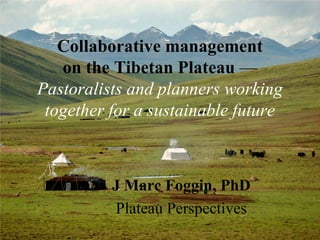
Foggin 2011 co-management
- 1. Collaborative management on the Tibetan Plateau — Pastoralists and planners working together for a sustainable future J Marc Foggin, PhD Plateau Perspectives
- 2. Background • Plateau Perspectives has worked in the Tibetan Plateau region since 1998, with geographic focus on the headwaters of the Yangtze River • Collaboration with local communities in establishing ‘community conserved areas’ • CCA’s subsequently incorporated in SNNR
- 3. • Plateau Perspectives’ main focus has been geographic, not thematic; such that work is collaborative in nature – i.e., working and walking alongside our partners (including local herders, government bureaus, conservation authorities such as the SNNR), not bringing or imposing our own external agenda • Collaborative approach is especially important for developing genuine partnerships with local herding communities – i.e., hearing and responding to felt needs
- 4. • Our main areas of work have included – Environ. management / conservation – Community health, education, etc. – Emergency relief (cf. earthquake)
- 10. • Major ‘ingredients’ for success include – Engaging most/all the key stakeholders – Working on appropriate timescales, not only according to formal project plans and funders’ cycles – Learning from ours / others’ experiences
- 11. Collaborative management • Managing natural resources involves understanding complex systems containing both human and natural components • Collaboration among multiple stakeholders crucial for successful resource management • To manage these systems, groups with divergent interests must work together (Blumenthal & Jannink 2000)
- 12. • ‘Co-management’ enables different groups to share in the management of natural resources within agreed structure and processes. The parties’ different capacities – knowledge, skills , resources, etc. – can thus be brought together for mutual advantage (Ross & Powell 2008)
- 13. The Sanjiangyuan region • Ecological region = 40 percent of province • Nature Reserve established in 2000, with State-level (national) status given in 2003 • Nature Reserve divided in ~18 sub-areas, each with three management zones • Overlapping with several prior ‘community conserved areas’ – now incorporated under trial ‘collaborative management’ schemes
- 14. Several models trialed so far… • ‘Community Co-Management’ (shiqu gongguan) • ‘Contract Conservation’ (boahu xieyi) • and other forms of community conservation (e.g., through development of community associations, NGOs, cooperatives, etc.)
- 15. Case #1: Muqu village • Since 1998 • Designation of local protected areas (PAs); monitoring of wildlife species; awareness raising; anti-poaching (monitoring) patrols • Integration with community development • Partnership with field station of SNNR for data collection; also partnership with NGOs
- 16. Case #2: Cuochi village • Since 1999 • Monitoring of wildlife species; designation of local protected area; local regulations • Partnership with SNNR field station, but mainly as contractual arrangement whereby the community is compensated in return for meeting agreed conservation goals • Partnerships with NGOs (capacity building)
- 17. • Based on these initial trials, SNNR (under the Forest Bureau) now is expanding the scope of experimenting with collaborative approaches to natural resource management and wildlife conservation; with the goal of learning how Collaborative Management could more effectively by introduced and used widely in the SNNR as well as other protected areas (PAs) in the province • To this end, a regional project to enhance the effectiveness of PAs is being developed
- 18. • It is important, more than ever, to protect the natural resources and proper ecological functioning of the Sanjiangyuan region… • Local communities are key stakeholders, and are potential partners in conservation
- 19. • ‘Collaborative management’ approaches may offer the best solution to date – not only to increase manpower, but also to help find/develop solutions for the sustainable use and effective protection of the natural heritage of the plateau region; as well as to enhance local people’s sense of well-being
- 20. • By partnering with all segments of society, we can achieve greater sustainability, conservation, and long-term socio-economic development (Foggin 2011)
- 21. Thank you!
- 22. Dr J Marc Foggin Plateau Perspectives Email: foggin@plateauperspectives.org Website: www.plateauperspectives.org
